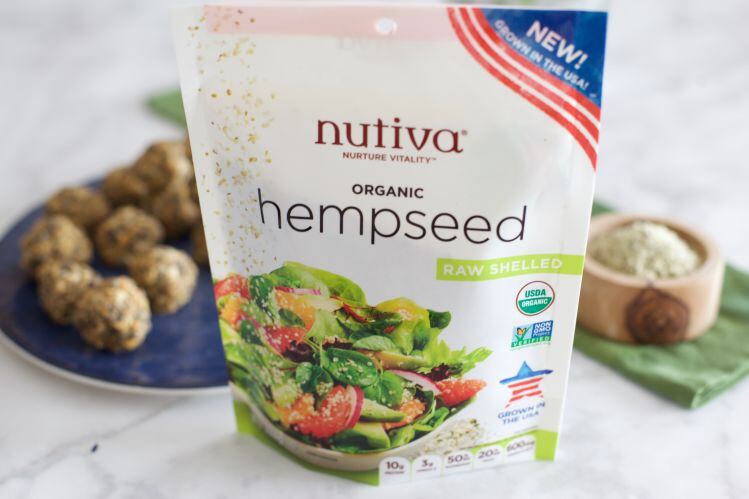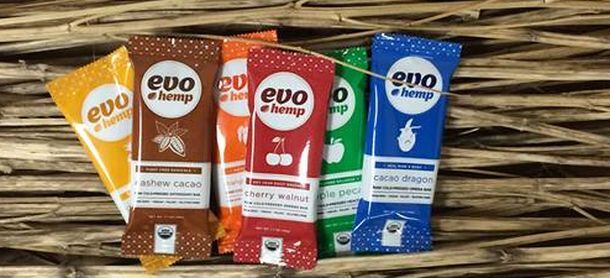According to SPINS data spanning natural, specialty gourmet and conventional (MULO) retail channels (which excludes online channels, convenience-stores and key retailers including Whole Foods, Trader Joe’s, ALDI and Costco, which explain why the figures may seem on the very low side*), the US hemp foods retail market was up 4.9% to $43.6m* in the 52 weeks ending February 25.
By far the biggest chunk of the market is represented by shelf stable grocery products (hemp seeds, bars, milks), which accounted for $40m (up 1.9% year on year); followed by frozen products, up 64.4% to $3.15m; and refrigerated products, up 18% to $272k.
The most explosive growth, however, came from cannabidiol (CBD) products (+356%), with shelf-stable candy up 267% and refrigerated juices and functional beverages picked up in the data for the first time.
Drilling down into applications, the biggest hemp food segments were nuts/trail mix/dried fruit products featuring hemp, up 11.5% to $15m, followed by shelf-stable plant milks featuring hemp (+11.6% to $13.5m), cold cereals (+26.2% to $5.8m) and shelf-stable wellness bars and gels (down 46% to $3.8m).
The fastest-growing segments – albeit off a very small base – were frozen desserts, refrigerated plant-based meat alternatives, shelf-stable functional beverages, and ready-to-drink tea and coffee.
Eric Steenstra, president at hemp advocacy group VoteHemp, said the market was likely considerably larger than the above dataset implies, with CBD sales now approaching $200m - outpacing hemp food sales - with the bulk of sales generated online and in other channels SPINS does not cover in the above dataset.
He told FoodNavigator-USA: "There hasn't been a year in the last seven where there hasn't been double digit growth and I don't believe 2017 was any exception."
Mitch McConnell’s new bill
As to the likely impact of McConnell’s yet-to-be released bill, the devil will be in the detail, but "from everything I've heard," said Steenstra, "I'm very encouraged that this is the best bill we've had yet."
Asked where CBD fits in, he said: "I haven't seen the final language, but while CBD won't be explicitly mentioned in the bill - which we believe will be introduced next week, the definition [of hemp] will be expansive and inclusive of all parts of the plant and I believe it will include the word 'extracts.' It's clear that Senator McConnell knows that CBD is a huge part of the industry in Kentucky.
"This is finally going to remove those things that were holding the industry back, including on issues such as banking, where in the past we've had banks refusing to do business in this sector and so on."
Any legislation that takes away some of the uncertainty surrounding industrial hemp will give the market a boost, predicted Nutiva boss John Roulac, who has been advocating to change the law for decades, given that hemp contains little to no THC, the psychoactive ingredient in marijuana.

“Hemp was growing really fast but has slowed a bit in the last year or two. We’ll see what happens, but I wasn’t happy with the recent House Bill (HR 3530) that would have basically allowed the DEA to conduct inspections of any hemp business with no cause. Hemp is an agricultural crop and the DEA should have no role in this going forward as it’s not a drug crop, not a controlled substance.”
For those unfamiliar with the backstory, while it is legal to sell and consume foods and beverages containing hemp seeds in the US, it is the only major industrialized country that outlaws domestic hemp production at a federal level (except for R&D purposes/ag pilots in select states under the 2014 Farm Bill), which has prompted many companies to source product from overseas (largely Canada), said Roulac.
Clarity on cannabidiol needed
And while US hemp acreage more than doubled in 2017 to 25,000+ acres (compared with Canada’s c. 100,000+ acres), he said, hemp farmers still face logistical and legislative hurdles that have hindered the full scale commercial cultivation of hemp to supply American consumers.
“This bill would reduce ambiguity in the industry and provide a clearer pathway forward for food and fiber applications, but the industry also wants clarity on CBD [cannabidiol – which is sourced from hemp leaves, stalks and flowers and is also non-psychoactive], which is where the biggest growth is right now. So if there is a clearer pathway on that from the federal government then I think you’ll see an explosion in acres. If it only allows for food and fiber that’s going to mean a smaller acreage.
“Historically we’ve imported hemp from Canada,” he said, “but at Expo West this year, we introduced the first certified organic hemp seed grown in the US [in Colorado], and were the first national brand to do that, and early feedback has been really positive. We also introduced a new plant protein blend featuring hemp, pea, sunflower and pumpkin. Hemp has a stronger flavor than pea, so blends work well.”
Hemp: Nutritional dynamite?

Hemp seed – an oilseed typically planted in June and harvested in October – has strong nutritional credentials, containing 25-35% protein; fiber; the short chain omega-3 fatty acid ALA; plus a small amount of the lesser-known fatty acids gamma-linoleic acid (GLA), which has anti-inflammatory properties; and stearidonic acid (SDA), which the body converts into the heart-healthy longer chain fatty acid EPA more efficiently than it converts ALA.
And when it comes to sustainability, which is becoming more important in purchasing decisions as plant- and animal-based food ingredients are pitched against each other, hemp tends to come out well as its cultivation requires few pesticides.
Amino acid profile
It’s not a complete protein, but compared to other plant sources, hemp stacks up pretty well, he said (hemp protein is high in arginine, which sports enthusiasts like as it is a vaso-dilator (arginine is a precursor to nitric oxide, which helps expand blood vessels and decrease blood pressure), and while it is low in lysine, it works well in combination with other proteins such as pea, which are high in lysine).
Hemp is also rich in iron, magnesium and zinc, which many Americans are short of, he said. “I sprinkle it on salad, soups, steamed veggies and smoothies, it’s easy to use and has a nice nutty flavor. The oil is not really suitable for cooking/frying, but it works really well with olive oil lemon juice and vinegar for salad dressings.”

Manitoba Harvest CEO: There is still a lot of confusion out there
Canadian brand Manitoba Harvest, which supplies branded snacks, seeds, protein powders, smoothie mixes, and oils, plus a growing ingredients supply business, contracts with a series of hemp farmers in Canada to grow seeds it supplies, but may start working with US farmers as well as the market expands, said CEO Bill Chiasson.
“We applaud efforts to expand acreage in the US and we are very open to working with producers wherever they are located.”
He added: “We're growing at a double-digit pace. Right now, hemp hearts are our biggest seller and they are growing the fastest, but we see protein powders as a big opportunity for future growth. We also see more snacking opportunities and new products in the ready-to-eat cereal market. But there are huge opportunities in the US because household penetration is around a tenth of what it is in Canada.”
Manitoba Harvest, which has recently secured self-determined GRAS (generally recognized as safe) status for all its hemp products, and is waiting to receive a ‘no objections’ letter from the FDA, is also spending a lot of time and energy on educating consumers and retailers about what hemp is - and isn’t – and how it relates to other cannabis products, he said.
“Things are changing but there is still a lot of confusion out there.”
Education – showing people how they can use hemp (adding it to smoothies, oatmeal, yogurt) – is key to market development, he said, coupled with simply creating more convenient products that incorporate hemp so consumers don’t have to work it out for themselves, he said.
"When our retail partners hemp seeds closer to the usage occasion - so next to salads, yogurts, and so on - it delivers a big lift."
* The SPINS functional ingredient attribute also captures hemp or CBD only when it’s the primary ingredient or is prominently marketed in connection with a product, so the data may exclude some hemp-containing products in which hemp is a less prominent ingredient.
What are the differences between hemp and marijuana?

“Hemp and marijuana are different varieties of the same species, Cannabis Sativa. Hemp and marijuana differ in both physical appearance, chemical composition and uses. Marijuana (short, wide and dense) is grown for its flowering buds containing high levels of THC; which creates the psychoactive ‘high’ marijuana is known for.
"On the other hand, industrial hemp (tall and narrow) is cultivated for its stalk, leaves and seeds which can be used to produce an array of products. As compared to marijuana, hemp’s trace amount of THC would be unsuccessful if attempted to use for psychoactive purposes.”
Source: Evo Hemp
The ‘Harvesting Liberty’ documentary by outdoor pursuits brand Patagonia has raised awareness about the benefits of farming hemp, which is drought tolerant, good for soil health, and does not require lots of pesticides and herbicides.
Technavio forecasts the global hemp-based foods market to grow at a CAGR of above 24% during the period 2018-2022.
